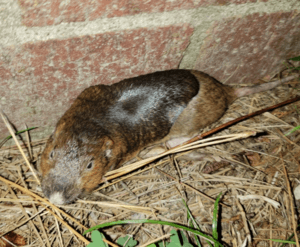Baird's pocket gopher facts for kids
Quick facts for kids Baird's pocket gopher |
|
|---|---|
 |
|
| Conservation status | |
| Scientific classification |
The Baird's pocket gopher, also known as the Louisiana pocket gopher (Geomys breviceps), is a type of pocket gopher found in the southern United States. These small rodents are known for their digging skills. There are three very similar kinds of eastern pocket gophers: Geomys attwateri, G. bursarius, and G. breviceps. Baird's pocket gopher is the largest of these three, while G. attwateri is medium-sized and G. bursarius is a bit smaller. It's hard to tell them apart just by looking at them, as their main difference is their size.
Baird's pocket gophers live in eastern Texas, western Louisiana, eastern Oklahoma, and southwestern Arkansas. They are expert diggers and spend most of their lives underground in tunnels. They have long, sharp, curved front claws that are perfect for digging. Living underground helps keep them safe from most predators. However, other digging animals like badgers and long-tailed weasels can sometimes be a threat. These gophers have special bacteria in their stomachs that help them digest different types of grasses. They also have a high number of babies, which helps their species survive. On average, a female Baird's pocket gopher has two to three babies at a time. They usually live for about 1 to 2 years in the wild.
Contents
What Does a Baird's Pocket Gopher Look Like?
Baird's pocket gophers are small to medium-sized rodents. They have a body shaped like a cylinder, with most of their weight closer to their head. Their eyes are very tiny, like beads, and their ears are just small flaps of skin.
One of their most interesting features is their external cheek pouches. These pouches are lined with fur and are used to carry food, much like a backpack! This is where the "pocket" in "pocket gopher" comes from. Their body gets thinner from the head down to the tail, widening a little at their thighs.
Fur and Tail
Short fur covers their body, ranging in color from light brown to black. The fur is usually lighter on their belly. Their tail is short, thick, and mostly bare, with very little hair at the base. It's about 6.5 centimeters (2.5 inches) long.
Feet and Claws
Their front feet are specially made for digging, with long, curved claws. Their back feet are smaller, about 3.1 centimeters (1.2 inches) long. It's almost impossible to tell Baird's pocket gophers apart from G. attwateri and G. bursarius just by looking at them. Scientists usually need to do genetic tests or know where they were found to tell the species apart.
Size and Weight
Male Baird's pocket gophers typically weigh between 180 and 200 grams (6.3 to 7 ounces). Females are a bit smaller, weighing about 120 to 160 grams (4.2 to 5.6 ounces).
Where Do Baird's Pocket Gophers Live?
Baird's pocket gophers are commonly found in the Gulf Coastal Plains of eastern Texas. They prefer certain types of soil. They like fine sandy soils and other soils where the topsoil is not very deep (less than 10 centimeters or 4 inches). They tend to avoid soils that become very hard and compact when dry, like dense clay. They also don't like soil that is too wet.
Underground Homes: Burrows
Baird's pocket gophers live alone underground in complex tunnel systems called burrows. They only come out of their burrows during very rainy periods to avoid getting flooded. Each burrow is usually about 6 centimeters (2.4 inches) wide and can be found anywhere from 10 to 68 centimeters (4 to 27 inches) deep underground. This means only one adult gopher can live in a single burrow system.
These burrow systems are very long, ranging from 55 to 180 centimeters (22 to 71 inches) in length. The tunnels wander around, often leading to different feeding areas. This shows that they dig mainly to find food. When they dig, they create crescent-shaped mounds of dirt on the surface. An average mound is about 30 by 45 centimeters (12 by 18 inches) wide and about 8 centimeters (3 inches) high. In winter, they build special mounds that include feeding areas, a cozy nesting room, a "bathroom," and even storage rooms for food!
What Do Baird's Pocket Gophers Eat?
Baird's pocket gophers eat a variety of plants, including grass, tubers, and different kinds of roots. They find most of their food while digging their tunnels and nests underground. They rarely come above ground to look for food.
As mentioned, they use their special "cheek pouches" to carry the food they collect back to their burrows. Like other rodents, Baird's pocket gophers have strong front teeth called incisors. These teeth help them dig through dirt and gather food.
How They Digest Food
To help them digest tough grasses and other plants, Baird's pocket gophers have special bacteria in their digestive system. These bacteria produce something called cellulase, which breaks down plant material.
They also have a unique way of getting the most out of their food. Like some other mammals, Baird's pocket gophers re-ingest fecal pellets. This means they eat their own droppings. While it might sound strange, this helps them use their food more efficiently, especially during winter or rainy seasons when fresh plants are harder to find.


